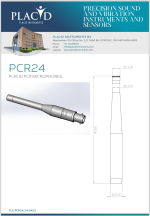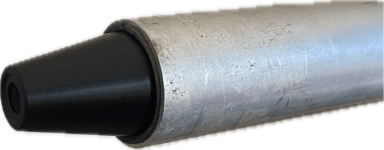I modified an old thin-walled steel broom pole. Looks awful, but it happened to be exactly the right diameter and I got an XLR in somehow...

At that price definitely worth consideration, so I had a closer, second look at the specification.
The noise for the PCR24 looks suspiciously low.
Usually the more tensioned membrane that produces a flat response to 40 kHz also reduces the sensitivity, so the noise floor in SPL is worse.
They claim a 40 kHz response, have a lower sensitivity but the noise floor barely any different, hmm.
Still looks fairly nice, buy one and satisfy everyone's curiosity 🙂
If it’s too good to be true…
What's wrong with the standard mic booms?
They are already quite thin, thinner than the diameter of most microphones.
Which is probably rather a bad thing instead of a good thing.
They are already quite thin, thinner than the diameter of most microphones.
Which is probably rather a bad thing instead of a good thing.
A few years ago I contemplated about a small microphone on a thin rod of at least 50cm. That, in fact, is still a good if not the best way to have the least intrusions in the direct sound field. And quite some loudspeaker developers use that technique. But I figured: 'hey, a pole of about 20-25mm that extends behind a standard microphone isn't a bad alternative to that and very flexible (for interchangeable microphones) too.' So I went the way I described above.
I also dropped a ref mic a few times (happens when you WORK) but never driped over a cabel! As sound guy you know how to handle cables ...A simple trick I learned back in my recording/broadcasting days: tape or bind the mic cable to the bottom of the pole stand, as close to the ground as possible. You prevent stumbling over the cable and, when pulled, the stand doesn’t go down easily.
I normally just coil the cable once around the pole and once around the arm of the stand - that's quicker as tape, quick to remove and also puts the cable close to the stand and low. There are also clips for cables which come with stands - good to secure the cables and a good sign of a beginner sound guy when used ;-)
Placid are responsive to emails.
Dimensions look good (to minimise diffraction)
I was given a quoted maximum voltage output is 8 volt =~ 20dBU.
with a 1/2” capsule that covers 20Hz to 40KHz, with a nominal sensitivity of 12mV/Pa (94dB), the maximum SPL should be around ~150dB.

Unfortunately, I have no way to verify that maximum observed level of ~150+dB, or what the SPL level it can observe whilst remaining low in distortion to be transparent to the driver under test.
Also, as @Dave Zan pointed out- there is a discrepancy- is the equivalent noise level 20dB, or 25dB?
Would anyone be interested in supporting @IamJF to add this mic to his microphone distortion testing thread?
Of course with @IamJF 's consent and generous time with testing / measuring microphones.
Dimensions look good (to minimise diffraction)
I was given a quoted maximum voltage output is 8 volt =~ 20dBU.
with a 1/2” capsule that covers 20Hz to 40KHz, with a nominal sensitivity of 12mV/Pa (94dB), the maximum SPL should be around ~150dB.

Unfortunately, I have no way to verify that maximum observed level of ~150+dB, or what the SPL level it can observe whilst remaining low in distortion to be transparent to the driver under test.
Also, as @Dave Zan pointed out- there is a discrepancy- is the equivalent noise level 20dB, or 25dB?
Would anyone be interested in supporting @IamJF to add this mic to his microphone distortion testing thread?
Of course with @IamJF 's consent and generous time with testing / measuring microphones.
Response from PLACID
“Selfnoise is not always clear. Our PMP20 (mic capsule) at 25 dB indeed, however it’s the microphone only.
PCR24 selfnoise is from the preamp, if included (PMP20) microphone it will be also around 25 dB.”
This is as I expected.
In the one corner we have the state of the art G.R.A.S. 46AC, observable response 3Hz to 40KHz (-1dB) that needs a traditional power supply that can supply the 200V polarisation voltage for the capsule, and 40V for the pre-amplifier, and with 20dB (self noise) to 164dB (3% distortion),
This is closely followed by the Bruel and Kjaer 4191L, with 21.4dB (self noise) to 162dB (3% distortion), again with the same frequency response and caveats as above.
And now we have a phantom power option that doesn't doesn't need an extra power $upply, can do 25dB to 150dB, 20Hz to 40KHz. And costs a 1/10th of the above...
“Selfnoise is not always clear. Our PMP20 (mic capsule) at 25 dB indeed, however it’s the microphone only.
PCR24 selfnoise is from the preamp, if included (PMP20) microphone it will be also around 25 dB.”
This is as I expected.
In the one corner we have the state of the art G.R.A.S. 46AC, observable response 3Hz to 40KHz (-1dB) that needs a traditional power supply that can supply the 200V polarisation voltage for the capsule, and 40V for the pre-amplifier, and with 20dB (self noise) to 164dB (3% distortion),
This is closely followed by the Bruel and Kjaer 4191L, with 21.4dB (self noise) to 162dB (3% distortion), again with the same frequency response and caveats as above.
And now we have a phantom power option that doesn't doesn't need an extra power $upply, can do 25dB to 150dB, 20Hz to 40KHz. And costs a 1/10th of the above...
Last edited:
I could help them with that, can measure acoustical self noise to at leat 9dBSPL(A) at my place. 😉“Selfnoise is not always clear. Our PMP20 (mic capsule) at 25 dB indeed, however it’s the microphone only.
PCR24 selfnoise is from the preamp, if included (PMP20) microphone it will be also around 25 dB.”
I'm quite busy at the moment with a new project (that's the reason I'm not so active here) but can for sure squeeze some microphone measurements in.
Wanted to add another option to the mix wrt budget calibrated mics.
"Dr. Jordan Design" in Germany offers a calibrated ECM8000.
My understanding is that this is nearly identical to the EMM-6.
Total, including shipping to NYC was $138.
Downside appears to be that this is on-axis only, but at this point it seems like the only sub $200 XLR mic with rigorous calibration data.
Happy to be proven wrong, as always.
"Dr. Jordan Design" in Germany offers a calibrated ECM8000.
My understanding is that this is nearly identical to the EMM-6.
Total, including shipping to NYC was $138.
Downside appears to be that this is on-axis only, but at this point it seems like the only sub $200 XLR mic with rigorous calibration data.
Happy to be proven wrong, as always.
Yup, we (over here) know that one. We also know some guys from Cologne that do a fairly reasonable job and offer a calibration service too, as does Dr Jordan btw.
I don't see the point of calibrating these low-end mics. They tend to drift quite a bit, so calibration gets useless after a couple of months.
Very interesting. I've not seen good data about mic drift. Please share if you have any.
I've seen and read anecdotal evidence of a M23 being stable for 5 years. As well as true condensers being stable for decades.
I've seen and read anecdotal evidence of a M23 being stable for 5 years. As well as true condensers being stable for decades.
Well, I can see the purpose of calibrating every 13 years!
Then buy a new one. Better a cheap reliable tool than an expensive one you can’t be certain of.They tend to drift quite a bit, so calibration gets useless after a couple of months.
Buying a calibrated
I compared my microphones repeatedly during a period of about one year. This included an Earthworks, an Isemcon, a Behringer 8000, and a fourth model which I don't remember what it was. The Behringer showed substantial drift (more than 2 dB), while the others were stable relative to each other. Sorry, this was a long time ago and I can't find the raw data right now.Very interesting. I've not seen good data about mic drift. Please share if you have any.
Why would I bother buying (not-so) cheap crap many times if I can simply buy a good microphone once?Then buy a new one. Better a cheap reliable tool than an expensive one you can’t be certain of.
No matter how a microphone isn't flat, or drifts over time, it does not affect the polars. You can accurately design and build without calibration, for example.. Then sit back and EQ the difference for a perfect end result.. (Something you'd have done anyway)
And how do you really, really know that ‘good’ microphone doesn’t drift? Because the manufacturer suggests so? And you trust that?Why would I bother buying (not-so) cheap crap many times if I can simply buy a good microphone
To my knowledge, in acoustics there’s quite a business in calibrating equipment frequently. Yes, we’re talking about metal film membrane externally polarized condenser mics and the subsequent electronics of way above 1k.
Furthermore, more expensive brands like Earthworks don’t specify why their stuff would be more long-term stable, if they put up that claim to start with. So my point stays I’d think.
- Home
- Loudspeakers
- Multi-Way
- Measurement mics
